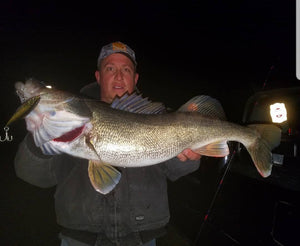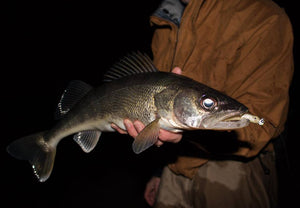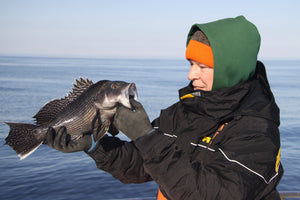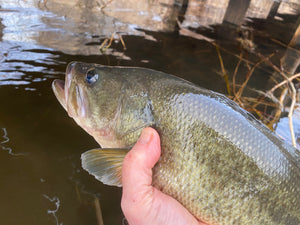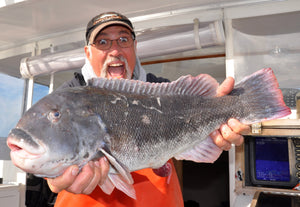Going Deep for Tilefish

There are days when slow-pitch jigging is king aboard the Miss Montauk II, here's Capt. Anthony Quaresimo with a nice one! Photo courtesy of Miss Montauk II.
Down, down, down it goes. You can see your bait descending far below the surface when you target tilefish in the offshore canyons. Still, even in the clearest water and most pristine conditions, it’s a long, long way to the bottom once your offering fades from sight.
There’s a reason they call this “deep drop” fishing,” says Capt. Anthony Gillespie, who skippers the open boat Atlantic Pearl for the Capt. Lou Fleet in Freeport. “Quite simply, it’s because it doesn’t get any deeper than this for most East Coast anglers.”
Indeed, tilefish, whether of the golden or less common blue line variety, live in burrows dug into sandy bottom some 400- to 1,000-feet below the surface. The hot spots in our region are no secret: Hudson Canyon, Block Canyon, Veatch Canyon - and other nicks along the continental shelf between Nantucket Island and Cape May, NJ. Of course, cruising that distance to get to the fishing grounds requires a substantial trip, so tilefish boats usually schedule excursions lasting 18 to 36 hours or more to ensure plenty of time at the rail over the most productive waters. Prices vary, too, depending on specifics, but expect to pay between $400 and $800 per person for overnight and two-day trips.

Be sure to dress for the weather on tilefish trips. It can be very different offshore compared to when you left the dock cautions Capt. Anthony Gillespie of the Atlantic Pearl, Freeport, NY. Photo courtesy of Capt. Lou Fishing Fleet.
Despite the distance, the water depth and, of course, the price, there’s no shortage of demand for tilefish trips. For some, they are a yearly occurrence while others consider them to be a “bucket list” item. Either way, reservations fill up quickly for these adventures.
That should come as little surprise when you consider the potential rewards. While most tilefish weigh 10 to 20 pounds, they can break the 50-pound mark. Deliciously sweet, they possess firm white flesh and can be broiled, baked, fried or even used in chowder. Add a little butter sauce to the table and the broiled or baked versions can be served as “mock crab.” Another plus for these trips is the high probability of seeing additional denizens of the deep hit the deck, including wreckfish, barrelfish, cod, white hake, rosefish, and more. Oh, did we mention that some tile trips are paired with tuna fishing since the two species sometimes share the same proximity?
In any case, you’ll want to be fully prepared when setting out on these cooler-filling voyages. That starts with dressing for the weather. Since most tilefish trips take place in the spring and fall, dressing warm and bringing along foul weather gear plus a complete change of clothes is the starting point for ensuring comfort and success.
“It can still get cold offshore this time of year,” advises Gillespie. “It gets breezy, too, so wear clothing that will protect you from the wind because that’s clearly one of the factors in how chilled you might get. Always overdress, never underdress.”
To that end, bring along some suitable foul weather gear including deck boots, skins, and a comfortable but water and wind-resistant hooded fishing jacket. You’ll also want to carry along plenty of snacks, a couple of sandwiches or small meals (not all boats have an open galley this time of year) and some options to quench your thirst. Keep your food items in a small cooler or cooler bag, but bring along a more substantial cooler with plenty of ice to hold your catch.
As for tackle, you want to think heavy-duty for these trips. Your first consideration in this regard, however, is checking if the vessel you are taking has rental rods and reels. Not all do. That’s an important consideration since standard gear includes an electric reel and rod combo or a heavy-duty conventional setup capable of handling 80-pound-test braided lines and sinkers weighing 2 – 4 pounds.

Tilefish have sweet, white flesh. This one is the perfect size for dinner. Photo courtesy of Capt. Lou Fishing Fleet.
“These are serious trips, so we like to load the boat with experienced deepwater anglers,” explains Capt. Jamie Quaresimo of the Miss Montauk II, which usually limits its tilefish trips to 16 anglers at the rail. “Most repeat fishermen with a few deep drop trips under their belts have suitable rods and reels in their arsenal and we like them having a setup with which they are comfortable. It really cuts down on the tangles and stress of cranking up your line from several-hundred feet deep.
“We stay to the eastern canyons but tend not to go as far east the Viking Fleet,” adds Quaresimo. “We’re one of the smaller boats making canyon runs, so if you are new to the game you might want to try a vessel with more elbow room.”
Gillespie, on the other hand, rents electric setups to those who need them. “Tackle choice is up to you,” he says. “You can go electric or conventional, but electric is definitely easier. Hand-cranking in 700 feet of water can be an arduous task if you are not conditioned to do it.”

This monster tilefish that Miss Montauk crew member Brian Damm cranked up from the depths fell for a clam bait on a simple, unadorned bottom rig. Photo courtesy of Miss Montauk II.
While electric reels certainly have the advantage in our view, tilefish rigs are a lot less complicated. In fact, the simpler you keep things the better you’ll do. A basic high-low rig with a 6/0 or 7/0 circle hook positioned five or six inches above the sinker, and the high hook tied-in eight inches above that, is standard. Most tilefish boats have rigs available on board. Clams, squid and sometimes fish strips are generally supplied as bait. Many anglers also bring along some “secret weapons” with salmon and fluke belly having most favored status.
To be sure, the choice of bait doesn’t seem to matter all that much on these trips – these fish like meat! It can, however, take a little while to get used to the bite. Think of the take as similar to fluke fishing. Sometimes you’ll feel the taps, other times you’ll just feel added weight or a “sluggish” feeling at the end of the line. Both signal it’s time to smoothly raise your rod and start cranking at a steady pace. Also as with fluke fishing, you’ll want to drop back some line every now and then to make sure your baits stay on or very near to the bottom – especially when the boat is drifting quickly due to strong tides or an uptick in the wind.
Braid or mono? That debate died out decades ago where deep drop action is concerned. “Don’t even think about bringing mono aboard!” says Gillespie. “Braided line only on my tilefish trips,” echoes Quaresimo. Braid wins out easily as its thin diameter and superior strength allow it to slice through the water with ease. That means you’ll get you baits the bottom quicker, need to pay out less line to stay there, better feel light taps transmitted up the line from several-hundred feet below, and enjoy more solid hook-sets since braid has far less stretch than monofilament lines. Braids are harder to untangle, but as long as everyone on board uses it tangles are lessened since the lines are more straight up and down than paid out with a lot of scope.

This pair of full-bodied golden tilefish were caught aboard the Atlantic Pearl, Freeport, NY. Photo courtesy of Capt. Lou Fishing Fleet.
How do tilefish fight? Surprisingly well, considering the deep-water battle. The tiles and other big bottom dwellers you’ll catch on these trips generally give a good account of themselves on the way up, although smaller fish tend to lose some of their will about half-way to the surface. Stay on those big ones, keep ‘em coming up as smoothly as possible, and don’t panic if they suddenly have a burst of energy. Once you’ve set the hook these fish the odds are very much in your favor.
Back to the rigging for a minute: It’s hard to not over-stress how important it is to keep them simple in the deep drop game. “ I see some people send down rigs that look like Christmas trees and Hula Hoops,” points out Gillespie. “I’m not saying you can’t add a couple of glow beads or a lightstick but anything more will just increase the resistance of your rig on the drift. That lifts the line off the bottom, making it less likely you’ll connect with tilefish and more likely you’ll tangle a rail mate. Remember, those fish live in burrows in the sand, so you want to stay tight to the bottom. The guys who add the most stuff to their rigs tend to catch the least fish on these trips.”
Situational awareness is important, too, preaches Gillespie. “If you see your line going over or under the person next to you, make an adjustment. Pass your rod under or over as necessary to keep your lines separated. Otherwise, those lines are going to have plenty of time to tangle as they are reeled to the surface. That’s going to result in a really big and nasty bird’s nest.”
Quaresimo follows the same logic in terms of standard rigging and presentation, but points out that some of his experienced passengers have also done exceptionally well using slow-pitch jigging approach. With jigs or bait, he advises, you still want to work your line with easy lifts and drops of the rod tip.
“If you can keep those offerings near the bottom and still impart some action, you’re going to do okay,” stresses Quaresimo. “You need to get your jig to the bottom and then raise and drop it like you would a regular diamond jig. Some guys in the know actually vary jigging motion based on what they see coming over the rail. Some will reel up three or four cranks while jigging, but that’s as high above the bottom as you want to get.”
Because Miss Montauk carries a relatively small passenger load affording extra elbow room, it’s probably a little better suited to a slow-pitch presentation than most other vessels, points out Quaresimo. “Our crew member, Brian Damm, is one of the best at the slow-pitch game. He proved it by drilling a 50-pound beast on a crew trip last season – his second 50-pound tilefish on a jig with us in the past two years!”
- Bryce Poyer

